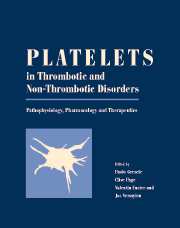Book contents
- Frontmatter
- Contents
- List of contributors
- Editors' preface
- PART I PHYSIOLOGY
- PART II METHODOLOGY
- 30 In vitro assays for evaluating platelet function
- 31 Monitoring antiplatelet therapy
- 32 Flow cytometric analysis of platelet function
- 33 Animal models of platelet-dependent thrombosis
- PART III PATHOLOGY
- PART IV PHARMOLOGY
- PART V THERAPY
- Afterword: Platelets: a personal story
- Index
- Plate section
30 - In vitro assays for evaluating platelet function
from PART II - METHODOLOGY
Published online by Cambridge University Press: 10 May 2010
- Frontmatter
- Contents
- List of contributors
- Editors' preface
- PART I PHYSIOLOGY
- PART II METHODOLOGY
- 30 In vitro assays for evaluating platelet function
- 31 Monitoring antiplatelet therapy
- 32 Flow cytometric analysis of platelet function
- 33 Animal models of platelet-dependent thrombosis
- PART III PATHOLOGY
- PART IV PHARMOLOGY
- PART V THERAPY
- Afterword: Platelets: a personal story
- Index
- Plate section
Summary
Role of platelets in hemostasis and thrombosis
Platelets play a primary role in the formation of the hemostatic plug at sites of vessel wall injury and in formation of thrombotic plug at the sites of atherosclerotic lesions. Platelets circulate as anucleated cells at the periphery of the bloodstream. When continuity of the endothelial layer is disrupted and the underlying matrix is exposed, platelets rapidly adhere to the exposed matrix through an interaction between the glycoprotein (Gp) Ib–IX–V complex on their surface and von Willebrand factor (vWf) in the subendothelium. The high fluid shear stress brought about by vascular constriction also promotes Gp Ib–IX–V–von Willebrand factor interaction. This initial interaction, often called platelet adhesion, sets the stage for other adhesive reactions that allow the platelets to essentially seal the vessel-wall defect.
Following adhesion, platelets are activated by a number of agonists such as adenosine diphosphate (ADP) and collagen present at the sites of vascular injury. These agonists activate platelets by binding to specific receptors on the platelet surface. Occupancy of these receptors leads to a series of downstream events that ultimately increases the intracytoplasmic concentration of calcium ions. Receptors coupled to the G-proteins such asADP, epinephrine, thromboxane A2 (TXA2) and thrombin receptors activate phospholipase Cβ (PLCb), whereas receptors activating via the non-receptor tyrosine kinase pathways such as collagen receptor GpVI preferentially activate phospholipase Cγ (PLCγ). Activation of PLCβ or PLCγ results in the production of the two second messengers: diacylglycerol (DAG) and inositol trisphosphate (IP3).
- Type
- Chapter
- Information
- Platelets in Thrombotic and Non-Thrombotic DisordersPathophysiology, Pharmacology and Therapeutics, pp. 459 - 470Publisher: Cambridge University PressPrint publication year: 2002
- 8
- Cited by



